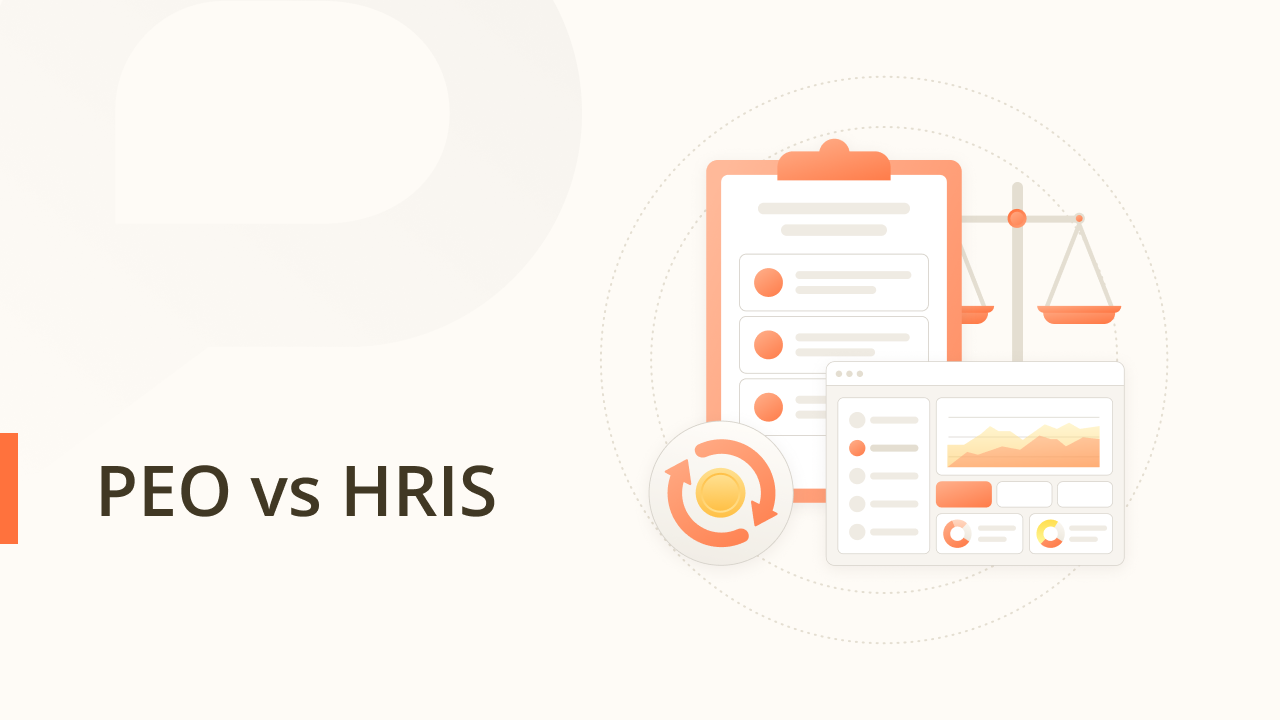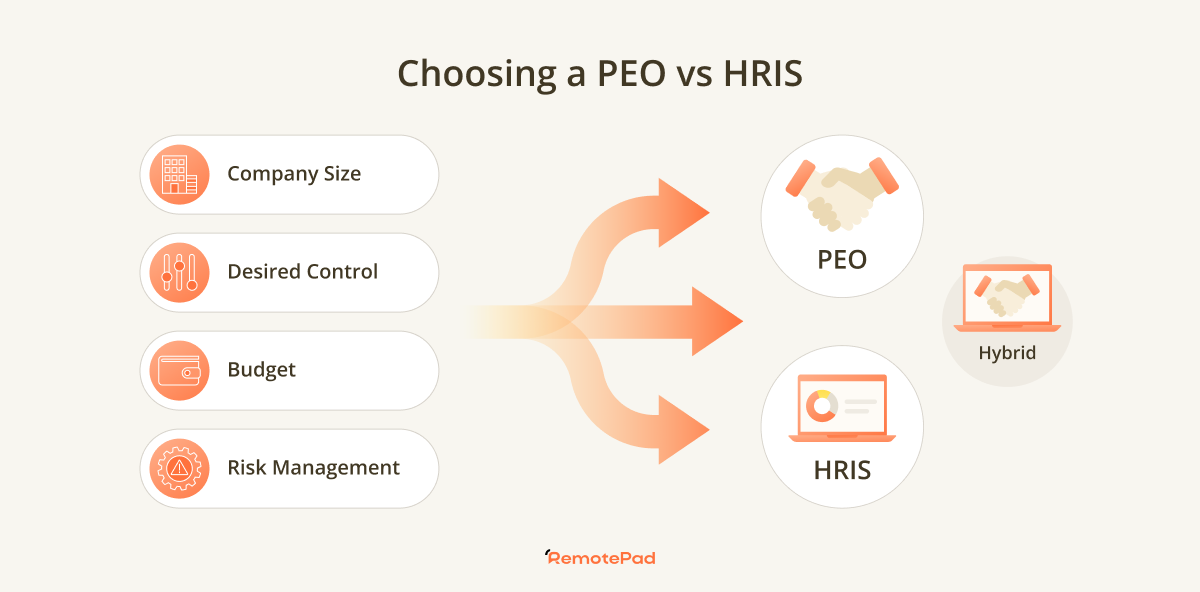Spending too much on recruitment, payroll or global HR?
We help you find the Best Providers at the lowest cost.
PEOs and HRIS both help manage HR tasks, but take different approaches. And the main differences between a PEO vs HRIS? A PEO acts as a full-service partner, handling payroll, benefits, compliance, and more for you. An HRIS, on the other hand, is software that provides tools to manage HR tasks yourself, but doesn’t take on the responsibility of those tasks directly.
Key Takeaways
- PEOs offer outsourcing, meaning the PEO handles HR tasks on your behalf, becoming a co-employer of your workforce.
- HRIS offers automation, meaning software tools that help to streamline your internal HR processes.
- One core difference exists in the level of control you have over your employees with PEO vs HRIS. A PEO offers less direct control over HR than an HRIS, which you manage directly.
Choosing the right tools for managing human resources is crucial for any business, big or small. But with options like PEO (Professional Employer Organization) and HRIS (Human Resource Information System) on the table, it’s easy to get tangled in the decision-making process. Each offers distinct features and benefits tailored to different business needs.
PEOs provide comprehensive HR solutions, including payroll, benefits administration, and compliance assistance, by co-employing your staff. On the flip side, HRIS systems offer a tech-savvy approach to managing HR tasks, focusing on software solutions to streamline processes. Understanding the nuances between PEO and HRIS can significantly impact your HR strategy and operational efficiency.
What is PEO?
A Professional Employer Organization (PEO) stands as a pivotal partner for businesses aiming to delegate their HR responsibilities. PEOs operate on a unique model known as co-employment, where they legally become the employer of record for a company’s workforce. This arrangement allows businesses to outsource critical HR functions such as payroll processing, benefits administration, workers’ compensation, and compliance with employment laws.
By affiliating with a PEO, companies gain the advantage of shared responsibilities. This means that while the PEO handles the complexities of HR management, business owners can focus on their core operations, driving growth and innovation. One of the most attractive features of partnering with a PEO is access to comprehensive employee benefits often reserved for larger enterprises. These benefits include health insurance, retirement savings plans, and other perks that significantly enhance employee satisfaction and retention.
Moreover, PEOs bring to the table a wealth of expertise in HR regulations and compliance, reducing the risk of legal issues that can arise from employment laws which are often complex and constantly changing. Businesses looking to expand into new territories can find immense value in PEOs, as they navigate the labyrinth of local, state, and federal regulations effortlessly, ensuring a smooth expansion process.
Despite the benefits, businesses must weigh the cost and degree of control relinquished when partnering with a PEO. For companies that value autonomy over their HR processes or require a more hands-on approach, a PEO might not be the ideal solution. However, for many small to medium-sized businesses, the trade-off between control and convenience is well worth it, paving the way for strategic growth and operational efficiency.
What is HRIS?
A Human Resource Information System (HRIS) is a type of software that companies use to manage internal HR functions. Unlike a Professional Employer Organization (PEO) that takes over many HR responsibilities through a co-employment model, HRIS provides businesses with the tools to handle these tasks in-house. This technology aims to streamline various HR processes, including payroll, recruitment, employee data management, and performance analysis.
HRIS systems are designed with efficiency in mind, allowing businesses to automate and optimize their human resources tasks. They serve as a centralized database that stores all employee-related information, making it easily accessible for HR professionals and management. With an HRIS, companies have the ability to track employee performance, manage benefits, and generate reports, all from one platform. This not only saves time but also reduces the likelihood of errors associated with manual data entry.
Choosing an HRIS offers businesses direct control over their human resources activities. It provides a level of autonomy and customization that partnering with a PEO cannot match. Businesses can tailor the system to fit their specific needs, ensuring that it aligns with their HR strategies and objectives. Furthermore, an HRIS can scale with the growth of the company, offering both robust functionality for large enterprises and simple, efficient solutions for smaller businesses.
The implementation of an HRIS also empowers employees by providing them with self-service portals. Through these portals, employees can access their personal information, request time off, and manage their benefits. This feature fosters a transparent and engaging workplace environment, promoting better communication between staff and management.
While HRIS allows companies to retain full control over their HR functions, it requires a certain level of IT support and expertise to manage and maintain the system. This need for internal management is a key consideration for businesses deciding between an HRIS and outsourcing HR functions to a PEO.
PEO vs HRIS: What are the Main Differences?
Deciding between a PEO and HRIS hinges on a business’s specific needs for HR management. While PEOs offer a comprehensive, outsourced solution for handling HR tasks, HRIS presents an in-house approach that brings efficiency and customization. By understanding the main differences—PEOs providing a hands-off experience and HRIS offering direct control and scalability—organizations can make an informed choice that aligns with their operational goals and HR strategy. Ultimately, whether a company leans towards the support and expertise of a PEO or the autonomy and flexibility of HRIS, the decision should enhance HR functionalities and contribute to the overall success of the business.
These are the main differences:
Scope of Service:
- PEO: A PEO functions as your outsourced HR department. They handle a wide range of HR functions on your behalf, becoming a co-employer for legal purposes.
- HRIS: An HRIS is a software suite that offers tools to help you manage your own HR functions. You retain responsibility and control.
Level of Outsourcing:
- PEO: High degree of outsourcing. You give up a portion of control over HR processes in exchange for comprehensive management by the PEO.
- HRIS: No outsourcing. You maintain full internal control over all HR processes, but get the benefit of automation and efficiency improvements.
Cost Structure:
- PEO: Typically charge per-employee fees, which can add up as your company grows.
- HRIS: Usually involve a subscription-based model, potentially offering a more predictable cost structure.
Choosing a PEO vs HRIS
Choosing between a PEO and an HRIS is about finding the solution that best aligns with your business’s specific needs and circumstances.
Here are some essential considerations to help you make an informed decision:
Company Size: Smaller businesses without a dedicated HR team often find tremendous value in the full-service outsourcing that comes with a PEO. Larger companies might have the resources to handle HR in-house with an HRIS for added control.
Desired Control: If you want complete oversight of HR practices or have very specific, customized needs, an HRIS provides more flexibility.
Budget: Evaluate the per-employee cost of a PEO vs. the subscription cost of an HRIS, factoring in your current and projected headcount.
Risk Management: PEOs often offer expertise in compliance and regulation. If minimizing HR-related risks is a major priority, the co-employment model of a PEO can be appealing.
Some solutions offer a hybrid approach, combining elements of an HRIS with certain outsourced PEO services. Carefully analyze what your business truly needs to make the most effective decision!
Comparing the Costs between PEO vs HRIS
Professional Employer Organizations (PEOs) and Human Resource Information Systems (HRIS) are two distinct solutions that organizations can leverage to manage their human resources (HR) functions and obligations.
While both offer benefits, they differ significantly in terms of their service models, cost structures, and the responsibilities they assume. Understanding the cost implications of each option is crucial for organizations to make an informed decision that aligns with their budgets and HR needs.
PEO Costs
- Co-Employment Model: PEOs operate under a co-employment model, where they become the employer of record for the client company’s employees. This arrangement allows the PEO to handle various HR tasks, including payroll processing, tax compliance, employee benefits administration, and regulatory compliance.
- Service Fees: PEOs typically charge a service fee based on a percentage of the client company’s total payroll. This fee can range from 2% to 12% or more, depending on the size of the organization, the services included, and the location. Larger companies with higher payrolls may be able to negotiate lower rates due to economies of scale.
- Additional Fees: Some PEOs may charge additional fees for specific services, such as worker’s compensation insurance, health insurance premiums, and other employee benefits. These fees can vary based on the chosen plans and the number of employees covered.
HRIS Costs
- Software Licensing: HRIS solutions are typically licensed software products that require an upfront purchase or subscription fee. The cost can range from a few thousand dollars for small businesses to hundreds of thousands for larger enterprises, depending on the features, number of users, and deployment model (on-premises or cloud-based).
- Implementation and Customization: Implementing an HRIS often involves additional costs for data migration, system configuration, customization, and user training. These costs can vary widely based on the complexity of the organization’s requirements and the scope of the implementation.
- Ongoing Maintenance and Support: HRIS vendors typically charge annual maintenance and support fees, which can range from 15% to 25% of the initial software cost. These fees cover software updates, bug fixes, and technical support.
- Additional Modules or Integrations: Many HRIS solutions offer additional modules or integrations for specific HR functions, such as performance management, learning management, or applicant tracking systems. These add-ons can incur additional costs based on the desired functionality.
- In-House HR Staff: Organizations using an HRIS are responsible for managing their HR functions internally, which may require hiring or retaining HR professionals to oversee the system and handle employee-related tasks. These internal HR costs can be significant, especially for larger organizations.
Cost Comparison Considerations
When comparing the costs between PEOs and HRIS, organizations should consider the following factors:
- Company Size: PEOs tend to be more cost-effective for smaller businesses that lack the resources or expertise to manage complex HR functions internally. Larger organizations with established HR departments may find HRIS solutions more economical in the long run, especially if they can leverage economies of scale for software licensing and support.
- HR Complexity: Companies with complex HR needs, such as those operating in multiple states or countries, or those with unique compliance requirements, may find PEOs more beneficial due to their expertise and dedicated resources for handling these complexities.
- Employee Benefits: PEOs often provide access to more comprehensive and cost-effective employee benefits plans due to their larger risk pools and negotiating power. This can be a significant cost advantage for organizations, especially those with limited resources or buying power for employee benefits.
- Long-term Costs: While PEOs may have higher upfront costs, they can potentially save organizations money in the long run by reducing the need for internal HR staff, minimizing compliance risks, and providing access to cost-effective employee benefits. On the other hand, HRIS solutions may have higher upfront costs but lower recurring costs over time.
Ultimately, the decision between a PEO and an HRIS should be based on a thorough analysis of an organization’s specific HR needs, budget constraints, and long-term strategic goals. Some organizations may even opt for a hybrid approach, combining elements of both solutions to optimize their HR operations and cost management.
Frequently Asked Questions
PEO stands for Professional Employer Organization. A PEO is a company that carries out HR and payroll functions on behalf of client companies.
PEOs can offer a number of advantages to businesses, including:
- Saving time and money on payroll processing, benefits and tax administration and HR
- Access to employee benefits that the company might not be able to provide on its own
- Compliance assistance with employment and tax laws and regulations
A PEO does usually provide payroll processing services, However, a PEO is much more than just a payroll company: In addition to handling payroll, PEOs can also provide access to employee benefits, compliance assistance, and other HR services.
PEOs are a great solution for small and medium-sized businesses that don't have the resources to handle all of their payroll and HR needs in-house. A payroll company, on the other hand, is often better for larger companies that already have a significant HR function in place.
A staffing company provides temporary or contract workers to businesses. If the worker is to become a fulltime employee they are usually hired directly by the client company.
A PEO, on the other hand, provides payroll, HR and compliance services to client companies and becomes the 'Employer of Record' for employees. The worker does not become a permanent employee of the client company.
Read more at PEO vs Staffing Company.
Yes, PEOs can provide assistance with benefits administration and health insurance. In addition to providing access to employee benefits, PEOs can also help with compliance, payroll, and other HR functions.
Yes, many PEOs offer services to assist with employee performance management, including the development of performance appraisal systems and strategies to improve employee productivity.
The National Association of Professional Employer Organizations (NAPEO) is a national organization based in the United States that represents the interests of Professional Employer Organizations (PEOs). PEOs are firms that provide comprehensive HR solutions for small and mid-sized businesses (SMBs), helping them streamline their HR management by offering services such as payroll processing, benefits administration, regulatory compliance assistance, and more.
NAPEO serves as an advocacy group, seeking to voice the concerns and interests of PEOs at both the state and federal levels. Apart from advocacy, NAPEO also provides a platform for PEOs to network, collaborate, and educate themselves on industry best practices. They work towards facilitating a favorable legislative and regulatory environment for the PEO industry to thrive in, fostering the growth and success of PEO businesses.
It hosts educational events, webinars, and conferences offering industry insights and the latest updates pertinent to PEOs. Furthermore, it produces research reports and other resources to support PEOs in their operations. NAPEO is an essential hub for PEO professionals, helping them navigate the complexities of the industry and stay abreast of trends and developments. It essentially works to foster the growth and innovation of the PEO industry in the US, promoting standards of excellence and ethical conduct among its member organizations. It is advisable to check the latest resources for the most recent updates regarding the role and initiatives of NAPEO as the information might change over time.
Yes, you can use a Professional Employer Organization (PEO) for just one employee. Many PEOs offer services to small businesses and startups with a minimal number of employees, including those with only one employee. Engaging a PEO for a single employee can still provide you with a range of benefits such as handling payroll, tax administration, and providing access to better health and benefits packages than a small business might be able to secure independently.
However, it's essential to note that different PEOs might have different minimum requirements, and while many are willing to work with very small businesses, others may cater primarily to organizations of a certain size. It is advisable to research and reach out to various PEOs to understand their offerings and whether they can accommodate a business with one employee.
Moreover, while utilizing PEO services for a single employee, it would be beneficial to analyze the cost-effectiveness of this approach, as the fees for PEO services might be substantial for a business with a very small number of employees. It is always a prudent strategy to carefully review any contractual obligations and the range of services provided to ensure alignment with your business needs and budget constraints.



